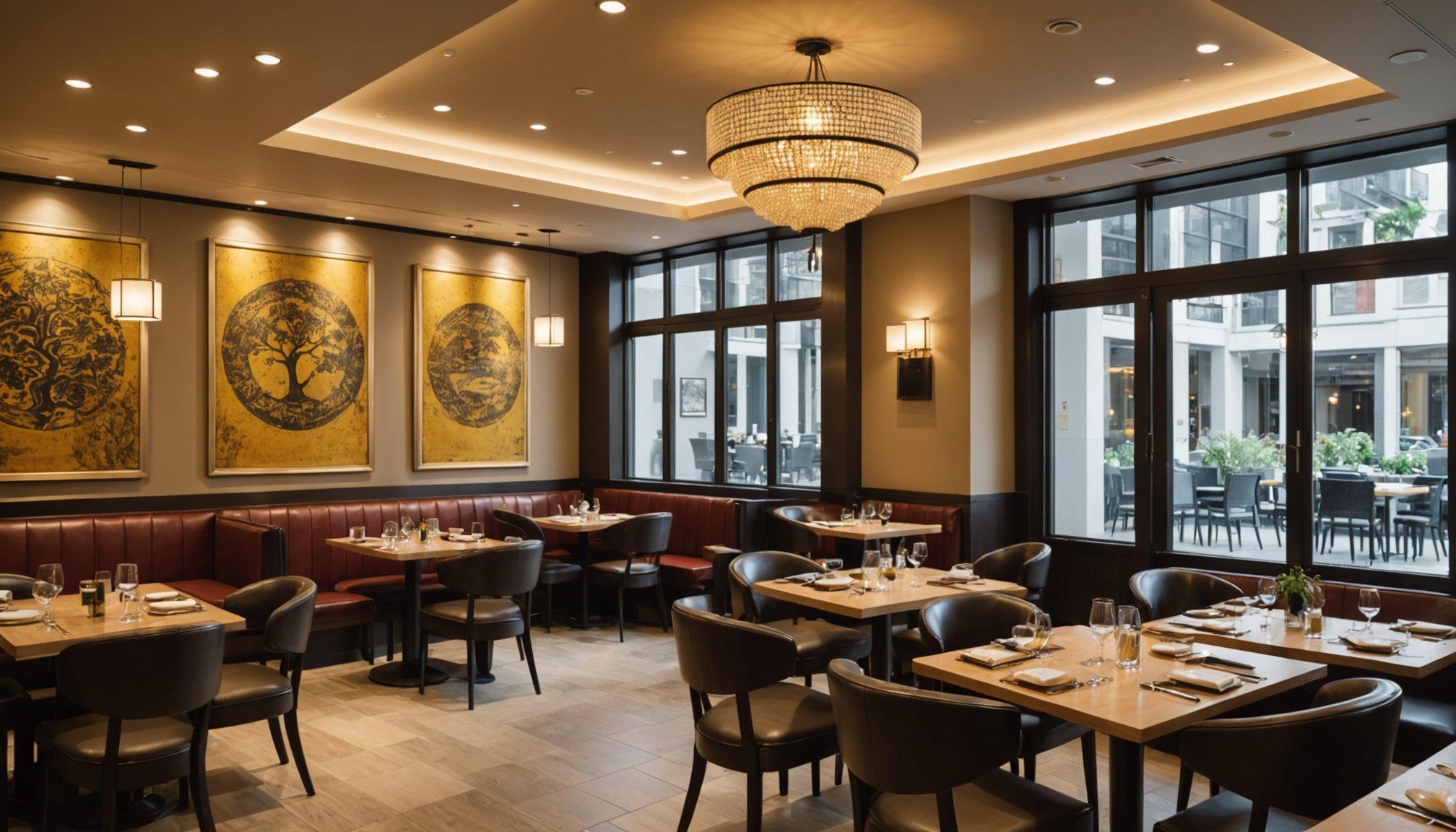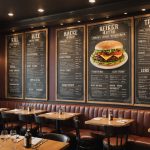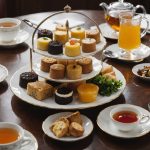Understanding Feng Shui Basics in Restaurant Design
Integrating Feng Shui principles into a restaurant’s design can significantly enhance the overall atmosphere, impacting both customer enjoyment and business success. At its core, Feng Shui focuses on creating balance and harmony within a space, which is essential in a dining environment. By understanding and applying these principles, restaurants can optimize their restaurant energy, promoting a sense of well-being for patrons.
Energy flow, or “qi,” is a fundamental aspect of Feng Shui, dictating how spaces feel and function. In a restaurant, smooth energy flow can influence the comfort level of guests, encouraging them to return. Proper energy distribution is achieved by ensuring open pathways, minimizing clutter, and arranging furniture in a way that supports natural movement and interaction.
Also to discover : Boost Profits: The Power of Menu Engineering in Themed Restaurant Success
Key elements of Feng Shui include the strategic placement of decor items and the choice of colors. Colors like warm earth tones or soothing blues can evoke certain emotions, complementing the desired ambiance. Incorporating elements such as water features or specific lighting can further refine the dining space’s harmony, offering a more inviting and comfortable environment for customers. By thoughtfully implementing these aspects, a restaurant can establish an appealing and harmonious dining experience that resonates with guests.
Assessing Your Restaurant’s Current Layout
Understanding your restaurant layout assessment is pivotal for a smooth dining operation. A well-organised layout can significantly enhance the flow of energy, or “qi,” promoting a positive atmosphere for both customers and staff. Evaluating the current structure is the first step toward achieving optimal energy dynamics in your restaurant.
Evaluating the Entrance and Its Importance
The entrance of a restaurant is more than just a doorway—it’s a customer’s first experience with your establishment. As such, it should invite prosperity and positive energy. Examine whether the entrance is welcoming, open, and free of obstacles that could hinder energy flow. A clear, unobstructed path encourages guests to feel relaxed upon arrival.
Identifying Energy Blockages
To ensure seamless energy flow, it’s vital to identify energy blockages in your restaurant. Cluttered spaces or poorly positioned furniture can create stagnation in energy distribution. Removing or rearranging elements that obstruct paths can improve spatial configuration, making the environment more conducive to a harmonious dining experience.
Measuring Customer Flow and Space Utilization
Understanding how customers navigate your space is essential. Conducting an analysis of natural pathways helps in spotting inefficiencies in layout. Look for bottlenecks or areas that feel cramped. Implementing changes to expand pathways can enhance movement and maximise space utilisation, leading to a more pleasant dining experience.
Practical Implementation of Feng Shui Principles
Implementing Feng Shui techniques in a restaurant demands thoughtful decisions in color, materials, and decor. The colors chosen can influence the harmonious atmosphere, impacting how patrons feel as they dine. Warm hues, like reds and yellows, can stimulate conversation and appetite, while cool shades, such as blues and greens, offer calmness and relaxation. Selecting materials that resonate with natural elements like wood or stone can further ground the space, fostering serenity.
Furniture Arrangement for Optimal Flow
Furniture should be strategically placed to enable a smooth energy flow, ensuring diners can move comfortably while maintaining an inviting and interactive setting. Tables arranged to face entrance points can create an open feel, while circular setups encourage community and connection, enhancing the overall restaurant decor and experience.
Decor and Accessories that Enhance Energy
Decorative elements shouldn’t just be aesthetically pleasing; they should also support a balanced energy field. Introducing items like mirrors can amplify light, while elements such as plants can purify the air and add vibrancy to the restaurant decor. Accessories with curves generally promote gentleness and steady flow, crafting a setting that aligns with Feng Shui techniques.
Case Studies of Successful Restaurant Transformations
Exploring Feng Shui success stories offers valuable insights into how restaurant environments can be enhanced by applying its principles. One notable example is the transformation of a restaurant that initially struggled with inconsistent customer satisfaction and poor layout. By redesigning their space with Feng Shui in mind, focusing on energy flow and spatial harmony, the establishment witnessed a significant improvement in customer experience. Incorporating warm tones, optimising furniture arrangements, and strategically placing decor elements resulted in a welcoming atmosphere. Customers reported feeling more at ease and were more inclined to return.
Another case study involves a modern bistro where Feng Shui principles were seamlessly integrated into the restaurant’s aesthetic. This restaurant saw a dramatic boost in business performance after implementing changes such as adding water elements and natural lighting. This harmonisation yielded higher patron engagement and repeat visits.
From these case studies, it’s evident that thoughtful application of Feng Shui techniques can transform restaurant spaces, boosting both customer satisfaction and business outcomes. Practical takeaways include the significance of energy flow in design and the enhancement of spatial aesthetics to create a captivating and harmonious dining environment. These success stories reaffirm the power of Feng Shui in crafting memorable customer experiences.
Visual Examples of Feng Shui Layouts in Restaurants
Visual representations of Feng Shui restaurant layouts can effectively communicate how design changes enhance spatial harmony. Transformations captured in before and after comparisons are particularly powerful. They provide clear insights into how simple adjustments can have significant impacts on energy flow and ambiance. By examining these visual changes, restaurant owners can better understand the tangible results of applying Feng Shui principles.
Before and After Comparisons
Images showcasing before and after layouts highlight the effectiveness of strategic design modifications. These comparisons often reveal how removing clutter, rearranging furniture, or incorporating natural elements such as water features can dramatically alter the space’s energy.
Layout Diagrams Illustrating Energy Flow
Layout diagrams are beneficial in illustrating how energy circulates within a restaurant. They can pinpoint hindrances like poorly placed furniture and suggest adjustments to improve overall energy flow and dining space harmony.
Mood Boards Capturing Desired Atmosphere
Creative mood boards play a vital role in capturing the desired atmosphere of a restaurant through visuals that reflect Feng Shui design concepts. They help in selecting suitable colors, materials, and accessories to create a harmonious and inviting environment for diners. These visual tools inspire and guide in crafting a balanced and aesthetically appealing restaurant space.
Benefits of Implementing Feng Shui in Your Restaurant
Integrating Feng Shui principles into your restaurant design can offer substantial benefits, impacting both immediate and long-term success. One of the foremost advantages lies in the creation of a welcoming, positive atmosphere that encourages customer loyalty. By fostering a harmonious energy flow, patrons feel more comfortable and satisfied, increasing the likelihood of repeat visits.
Positive energy extends beyond customer satisfaction—it also enhances employee productivity. A thoughtfully arranged dining space can lead to improved staff morale and efficiency, as workers navigate the restaurant with ease and feel invigorated by their surroundings. Employees performing at their best translate into better service for customers, solidifying the restaurant’s favourable reputation.
Long-term financial benefits also accompany this enhanced atmosphere. With an increased number of satisfied and returning customers, there’s a notable rise in revenue. Furthermore, the consistent positive energy impact and appealing environment created by Feng Shui can reduce employee turnover, saving costs related to hiring and training new staff.
Ultimately, the application of Feng Shui principles not only elevates the environment but also reinforces a cycle of success, enhancing overall business outcomes through improved customer and employee experiences.











